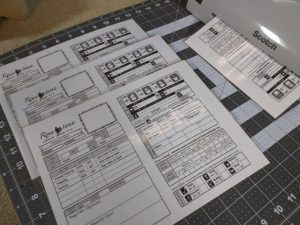Successfully running an RPG at a convention is an art form (one I haven’t mastered). It’s loud and everyone’s under tight time constraints. (Dire Bear Adventuring Co. did an excellent job running D&D at the last few Hamacon events, if you want a good example.)
Here’s a few quick rules I use when running games at cons:
Respect your players’ time. This is my #1 rule, but I’m bad at following it. In an ongoing campaign you play at home, it’s fine to take extra time on details like character customization and storytelling flourishes during character downtime–those can be the most memorable parts. But at a convention, every hour of your players’ time has a massive opportunity cost because there’s so much else going on. Decide what experiences you want to emphasize in your game, and focus on those.
Have pre-generated characters. Since rolling a character can be the most time-consuming part of the game, skip it. If players really want this, offer it between games. This is also good for people unfamiliar with the game, because they don’t start out with an overwhelming number of choices.
The worst game I’ve ever played at a con was a non-D&D RPG that was blocked off for four hours. I had plans immediately after its time block. The (well-meaning, enthusiastic) GM walked us through character and the collaborative world creation process. I honestly don’t think he picked up on how antsy we were getting. Over an hour into the process, the group fell apart before we started playing the actual game.
Have a wide variety of pre-generated characters. For example, my Ryuutama pregens have each class and each type of seasonal magic represented (though not one of each combination). If you’re playing D&D, have at least one of each class and each race, and consider subraces and character archetypes if you feel players benefit from the variety.
Cut out any unnecessary bits. I ran The Beast recently for a one-hour podcast, and I’m still kicking myself for including an opening scene where the heroes ride into town. Did it help set the mood? Sure, and if we had four hours it would’ve been fine. But abruptly ending the game after the first minor encounter felt underdeveloped and poorly paced–worse than railroading them into the plot.
Consider many younger players’ experience is from Critical Role and/or streaming alone. The last few years, I’ve seen younger players curious if we had D&D because they’d watched it played online, but had never played themselves. I was introduced to RPGs in the 90’s, so this is hard to wrap my head around. This means a few things:
- Your D&D game could very well be someone’s first RPG experience. If you’re not labeling it as intermediate/advanced, ease into player rules. Don’t start too high level since the extra options can be overwhelming. Have references and cheat sheets to help players understand what they can do. (For example, when I run Ryuutama, I have printouts of the different types of journey checks, concentration, and combat actions from the PDF.)
- Standard vanilla D&D may get far more interest that any other unique gaming experience you might offer. This seems backwards for experienced gamers–why spend valuable con time on something you could play anytime, anywhere? Well, if all you’ve ever experienced is watching a game online, you don’t want something new and overwhelming. You want the game you already vaguely understand how to play. I’ve had people walk away because D&D sign-ups are full, even though I’ve got an empty sign-up sheet for Ryuutama.
- Web series focus on presentation and experience over mechanics, so that may be the lens through which they view RPGs. Did you give them a chance to laugh, or to interact with other players or the world in some entertaining way? That’s probably more valuable than whether you challenged them technically or stuck to the rules.

Prep your gear for distribution and reuse. For example:
- I pack individual sets of dice in 3″ plastic food containers, so it’s easy to pass them out when we get started.
- I laminated my pre-generated characters and Ryuutama battle sheet for reuse, and I bring wet-erase markers, whiteboard cleaner, and paper towels. (That way, I don’t have to remember to print new copies before every con.)
- Rather than try to carry a wide variety of miniatures, I take a minimalist approach with several colors of meeples (from the BoardGameGeek store) and colored glass stones (sold as vase filler in most craft stores).
